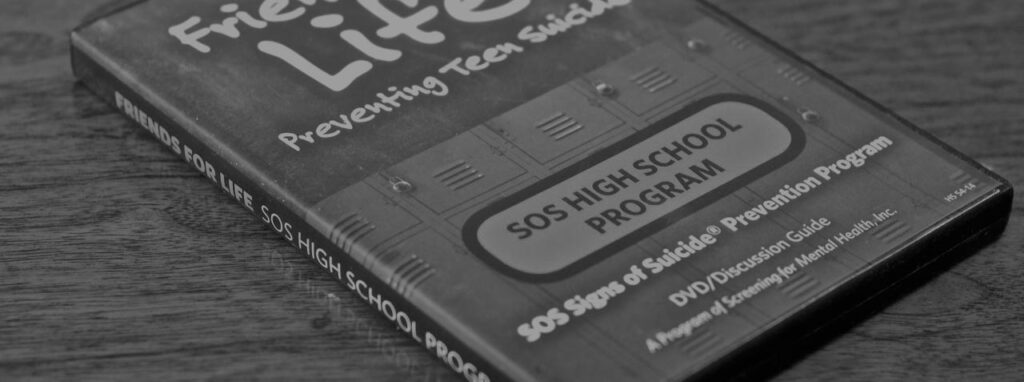 Screening for Mental Health, Inc.
×
Screening for Mental Health, Inc.
×

PREVENTION & EDUCATION
The standard SOS program follows a carefully designed structure combining educational content delivery with mental health screening in an integrated format. This dual-component approach distinguishes SOS from programs offering only education or only screening, providing comprehensive prevention addressing multiple pathways to suicide risk identification and intervention.
Program implementation typically occurs over one to two class periods, making SOS relatively efficient while maintaining depth and impact. The compact timeframe respects instructional time constraints schools face while ensuring sufficient coverage of critical content. This efficiency has contributed to widespread SOS adoption, as schools can implement high-quality suicide prevention without extensive schedule disruption.
Sequential delivery matters significantly for program effectiveness. The standard SOS structure begins with educational content establishing foundation knowledge about depression and suicide before moving to screening. This sequence ensures students possess context for understanding screening questions and recognizing symptoms in themselves. Education preceding screening also normalizes mental health assessment, reducing anxiety students might feel about completing screenings without prior preparation.
The educational curriculum forms the first major component of the standard program, delivered through structured lessons incorporating video presentations, guided discussion, and interactive activities. These materials present information in engaging, age-appropriate formats designed to maintain student attention while covering sensitive topics respectfully.
Video presentations anchor the educational experience, featuring realistic scenarios showing warning signs of suicide and depression in young people. The videos depict adolescent characters facing mental health challenges, demonstrating both warning signs and appropriate responses. Students see peers navigating difficult situations, making content relatable and memorable. Characters in the videos model help-seeking behaviors, showing students that reaching out for support represents strength rather than weakness.
Following video viewing, facilitators guide structured discussions helping students process content, ask questions, and connect information to their own experiences. Discussion questions prompt reflection on warning signs observed in the video, appropriate responses to concerning behaviors, and available resources for support. These conversations build critical thinking about suicide prevention while allowing students to clarify misunderstandings.
The ACT framework provides students with clear, actionable steps for responding to suicide warning signs. This memorable acronym teaches students to Acknowledge signs of suicide without dismissing or minimizing them, Care by showing support and concern for the struggling individual, and Tell a responsible adult who can provide professional help. The framework’s simplicity makes it accessible to all students while providing concrete guidance for potentially life-saving action.
Education also addresses common myths and misconceptions about suicide. Students learn that asking someone about suicidal thoughts does not plant ideas or increase risk, that suicide can affect anyone regardless of appearance or circumstances, and that most people showing warning signs do want help even if they seem resistant. Dispelling these myths empowers students to act on concerning observations rather than hesitating due to misinformation.
PROMOTIONS & SUPPORT
Following educational content delivery, students complete brief mental health screenings assessing depression symptoms and suicide risk factors. The standard SOS program utilizes validated screening instruments designed specifically for adolescent populations, ensuring age-appropriate language and developmentally relevant questions.
The screening process maintains confidentiality while enabling identification of at-risk students. Students typically complete paper-and-pencil or electronic screenings responding to questions about mood, sleep, appetite, energy, concentration, feelings of hopelessness, and thoughts of death or self-harm. Screening instruments used in standard SOS have undergone rigorous research validation, demonstrating reliability and accuracy in identifying youth experiencing depression and suicide risk.
Students receive clear instructions about screening purpose, confidentiality protections, and what happens with results. This transparency builds trust and encourages honest responses. The standard program emphasizes that screenings are not tests with right or wrong answers but tools for identifying students who might benefit from additional support.
The standard program includes detailed protocols for responding to students screening positive for depression or suicide risk. These systematic procedures ensure appropriate, timely intervention for every identified student.
Trained school personnel review screening results, identifying students requiring follow-up. The standard protocol specifies review timeframes, typically requiring completion within 24 hours of screening administration. This rapid turnaround ensures at-risk students receive prompt attention.
Designated mental health professionals including school counselors, social workers, or psychologists conduct individual follow-up meetings with students screening positive. These confidential conversations provide opportunities for more comprehensive assessment, discussion of concerns, and collaborative development of support plans. Mental health professionals assess immediate safety, determine whether students require emergency intervention, and identify appropriate next steps.
Parent notification represents a standard protocol component balancing student privacy with appropriate family involvement. Schools contact parents when students screen positive, explaining findings and recommending additional evaluation or treatment. The standard program provides templates and guidance for these sensitive conversations, helping schools communicate effectively with families.
Referrals to community mental health services connect students requiring treatment with appropriate providers. The standard program emphasizes importance of established referral networks enabling smooth transitions from school-based screening to community-based care. Schools maintain resource directories listing local mental health providers, crisis services, and support resources.
The standard SOS program requires training for personnel involved in implementation. This training ensures consistent, high-quality program delivery across diverse school contexts.
Facilitator training prepares educators to deliver curriculum effectively, manage classroom discussions about sensitive topics, respond to student emotional reactions, and recognize situations requiring immediate intervention. Training typically occurs through in-person workshops, online modules, or combination formats providing both instruction and opportunities for practice.
Mental health professionals receive specialized training in screening administration, result interpretation, risk assessment, safety planning, and crisis response. This advanced preparation ensures appropriate expertise for handling complex situations that may arise during screening and follow-up.
While maintaining core components essential for effectiveness, the standard SOS program allows some flexibility in implementation details. Schools can adapt delivery formats to fit their schedules, choose appropriate timing within the school year, and coordinate with existing student support systems. However, research emphasizes that maintaining program fidelity regarding core components including video-based education, ACT framework instruction, validated screening tools, and systematic follow-up protocols is essential for achieving documented positive outcomes.

RISK MANAGEMENT & LIABILITY
The standard SOS program has undergone extensive research evaluation demonstrating effectiveness in reducing suicide attempts and improving knowledge, attitudes, and help-seeking behaviors among participating students. This robust evidence base has earned SOS recognition as a Substance Abuse and Mental Health Services Administration evidence-based practice, validating the standard program structure as worthy of widespread implementation.
Multiple randomized controlled trials and effectiveness studies conducted in diverse school settings across the United States have documented consistent positive outcomes. This research foundation provides schools with confidence that implementing the standard SOS program with fidelity will benefit their students and communities.
The standard SOS Signs of Suicide program provides schools with proven tools, clear protocols, and evidence-based approaches for youth suicide prevention. By implementing this comprehensive program following established guidelines, schools create safer environments where struggling students receive identification and support that can save lives.

FEATURED PROGRAMS
SOS Second Act is designed to build resiliency in young adults. In addition to reviewing the signs and symptoms of depression and suicidality, students are prompted to discuss substance abuse and other risky behaviors. Students are provided with a solid foundation on health care basics, health insurance, and self-care tips on seeking mental health treatment in the “real world.”
The Online Parent Brief Screen for Adolescent Depression (BSAD) allows parents to assess their child for suicide or depression risk factors. After parents complete a series of questions online, the screening provides results, local referral options (determined by each school), and relevant, educational information.